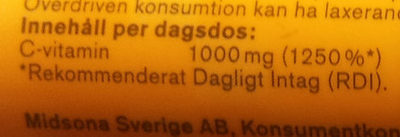C-vitamin citron - Friggs - 80 g
This product page is not complete. You can help to complete it by editing it and adding more data from the photos we have, or by taking more photos using the app for Android or iPhone/iPad. Thank you!
×
Streckkod: 7313902800733 (EAN / EAN-13)
Vanligt namn: Sockerfria brustabletter med vitamin C
Kvantitet: 80 g
Förpackning: Plast
Varumärken: Friggs
Kategorier: Kosttillskott, en:Vitamins
Länder där såld: Sverige
Matching with your preferences
Hälsa
Food processing
Tillsatser
Ingrediensanalys
The analysis is based solely on the ingredients listed and does not take into account processing methods.
Portionsstorlek:
4 g
⚠
️Serving size is too small (5 g / 5 ml or less) to calculate 100 g / 100 ml values and perform any further nutritional analysis








